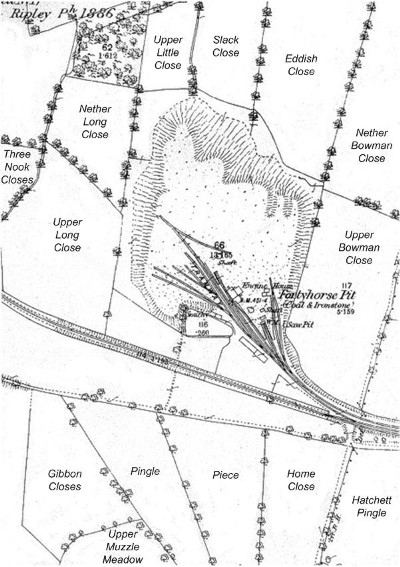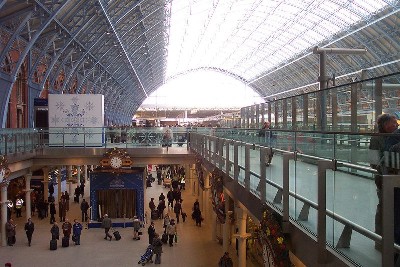
Forty Horse Pit
The Forty Horse Colliery was situated behind what is now the Codnor Gate industrial Estate and was part of the Knowts hall estate.
An article in the Derbyshire Times on 25th January 1930, discussed the working life of former collier Mr Francis Ottewell, who was a former resident of Codnor and spent many years working at Forty Horse pit.
The article confirms that the colliery was named after the 40 horse power steam engine that worked the pit.
Previously it was thought that it was named after 40 ponies that died in the pit, but this is a mistake and confused with an incident that happened at the nearby Butterley Park No.2 pit and documented in Joseph Millot Severn’s book ‘My Village’ a transcript of which can be read by clicking this link.
Further research also confirms that 40 horsepower steam engines were developed by the Butterley Company during the 1830s to compete with similar sized engines manufactured by companies like The Horsley Iron Company.
Fig.1 A plan view of Forty Horse Pit in 1881, showing the mineral railways that connected it with High Holborn colliery to the right
and Butterley Iron Works to the left. I have named the fields that I know. Also the spoil heap covers three fields called 'Near Pasture', 'Far Pasture' and 'Long Close'.
The pit was sunk by the Butterley company in the 1840s to work two coal seams, the soft coal seam at 5 feet thick and the hard coal seam at 7 to 8 feet thick. It also worked an Ironstone seam, and it was this pit that provided the Ironstone used by the Butterley company to manufacture the arches in the roof of St. Pancras Station in London. The total cost of the 24 rib roof and glazing was over £53,000, of which over half was for the main ribs. When the roof was completed in 1868 it measured 210m long and spanned a gap of some 75m, making it the largest covered space in the world.
Joseph Millott Severn, author of ‘My Village’ worked at the Forty Horse Pit for one and a half years. It was here were he nearly lost his life when a roof collapse knocked him to the floor and completely buried him. He was lucky enough to be able to wriggle free from the debris and escape with only a few cuts and bruises.
Nottinghamshire Guardian, Thursday 21st February 1856
FATAL COLLIERY ACCIDENT
On the 7th and by adjournment on the 14th instant, The Coroner held an inquest at the Lord Nelson, Kimberley, on the body of a collier named Joseph Swann, aged 41 years.
It appears from the evidence that in the morning of the 24th ultimo, the deceased proceeded to his employment at the Butterley Colliery and descended the shaft known as the 40-Horse Pit.
Although he was fully aware of the danger attending the carrying of an exposed lighted candle through the works he neglected the precautionary measure of providing himself with a safety lamp and during his progress through the mine his candle ignited the accumulated gasses and an explosion ensued, which inflicted very severe burns on various parts of his body.
The force of the explosion also blew a man backwards who was some distance behind the deceased, but he sustained no material injury.
The deceased was removed from the pit and lingered until the 5th inst., when he expired.
The pit closed in the 1890s but the buildings remained in place and were used as central workshops for all the other pits in the area. The shaft was fitted with a fan and acted as a ventilation shaft for High Holborn pit.
Sheffield Daily Telegraph, Friday 23rd October 1868
SHOCKING DEATH AT RIPLEY.
Early yesterday morning some workmen employed at an Ironstone pit at Butterley Park, near Ripley, on going to work found at the bottom of the shaft the body of a youth about 16 years of age. It was found that he had been employed by the Butterley Company as a coal miner and worked at the 40-Horse Pit.
He had his snap bag and bottle strung round his neck when found. The company had just fixed one of King’s patent apparatus to the shaft of the Ironstone pit and it is thought probable that the deceased had gone to look at it on his way to work and by some means had fallen down the shaft.
Remains of the pit buildings still existed in the 1960s as did the pond that provided water for the steam-winding engine. This was known as ‘Goss pond’ by the locals and if I remember correctly, had an old car dumped in the middle of it. All signs of the buildings and pond were removed when the Codnor Gate industrial estate was built. Gorse bushes grew on the old pit hill, which was planted with hundreds of saplings that have now grown and created lush woodland.
Fig.2 A view of the arched roof at St. Pancras station, built by the Butterley Company using Ironstone mined from Forty Horse Pit.
Copyright (c) 2007 Chris Wood. Dual-licensed by the copyright holder under the terms of the Gnu Free Documentation License and Creative Commons Attribution.
Information for this page was obtained from the following sources.
The Heritage of Codnor & Loscoe, by Fred S Thorpe 1990
A History of Mining in the Heanor Area, Heanor & District Local History Society publication 1993
Ripley & Heanor News, January 21st 1972
Derbyshire Times 25th January 1930
My Village, by J M Severn 1932
http://en.wikipedia.org/wiki/St_Pancras_railway_station

